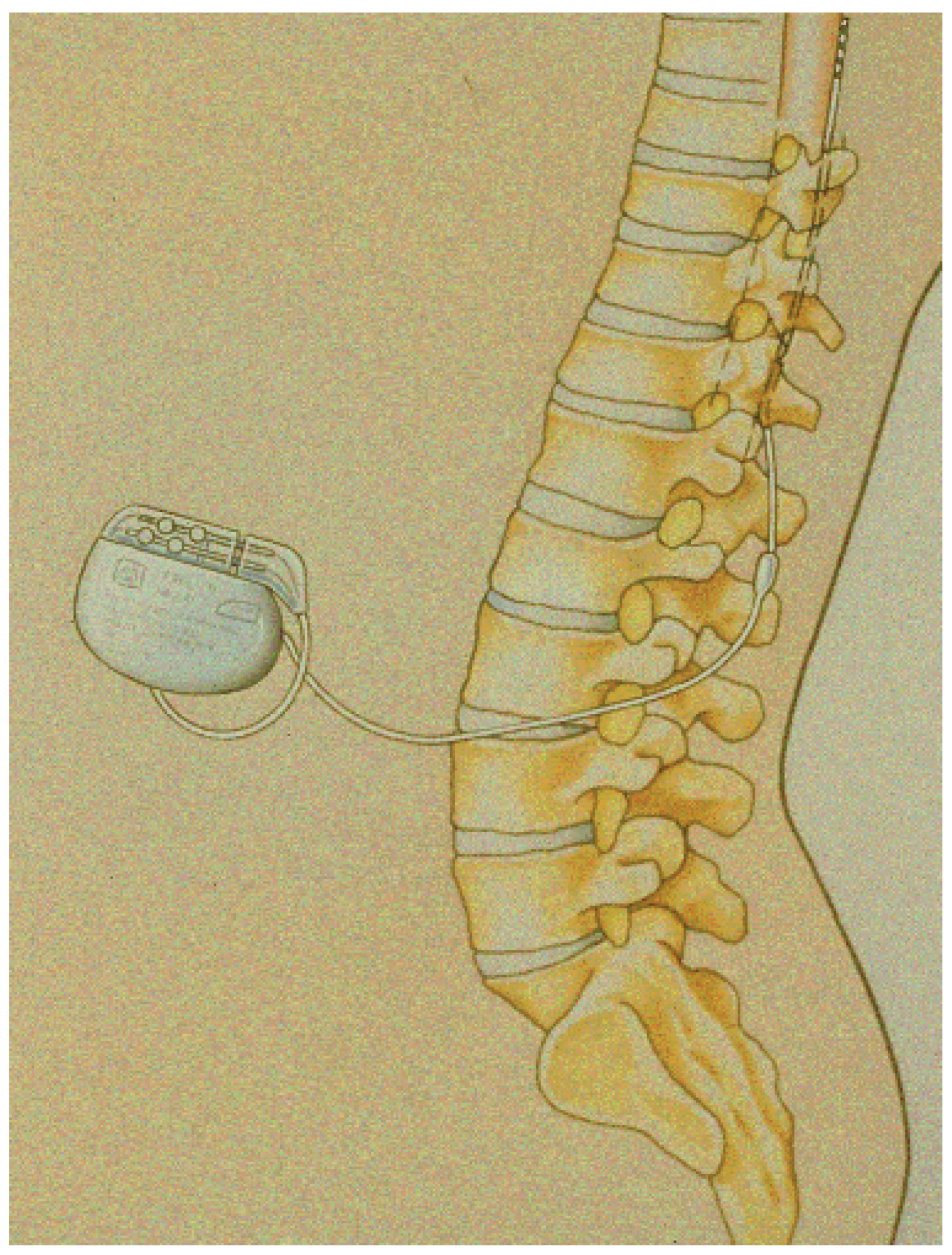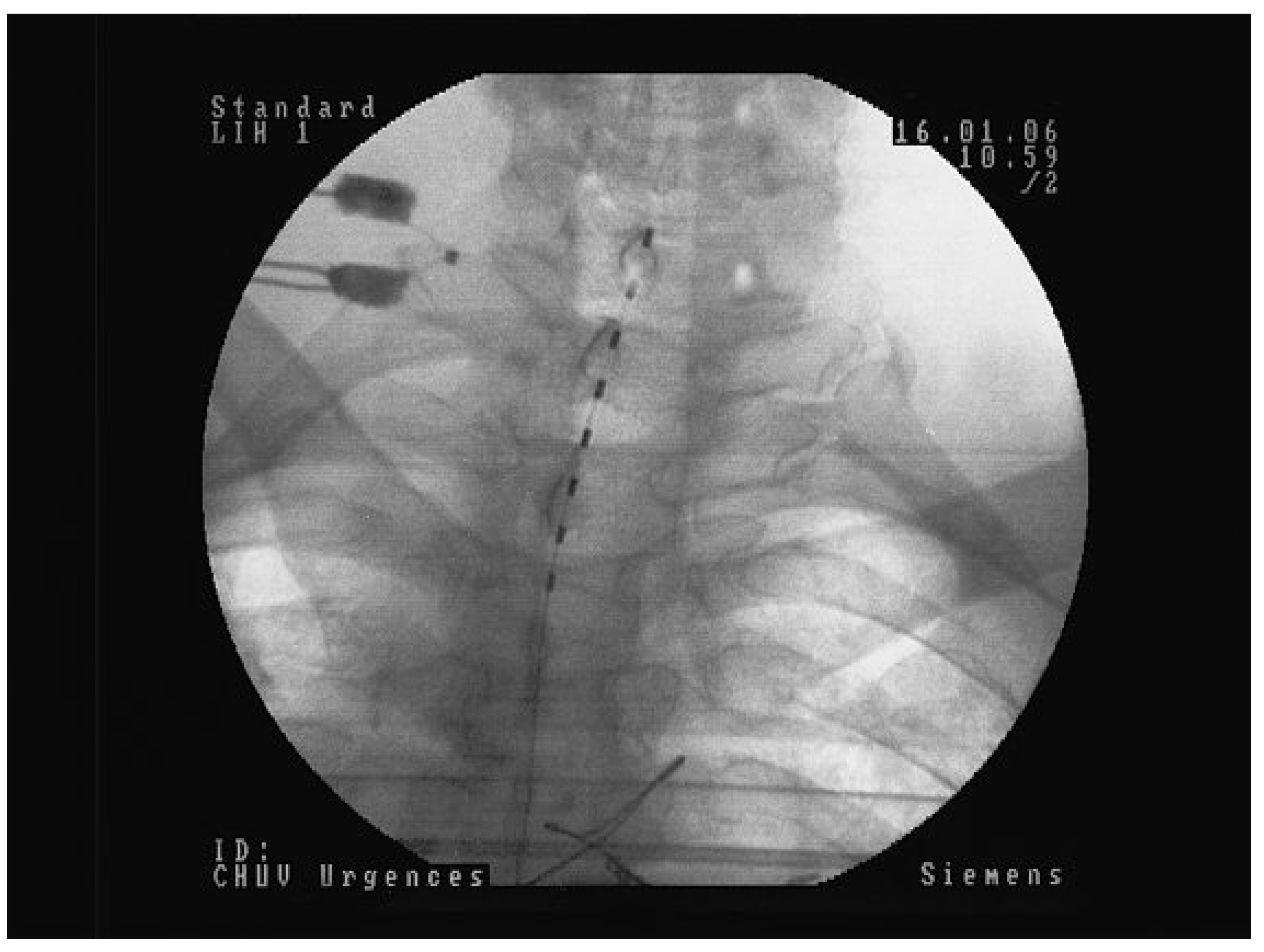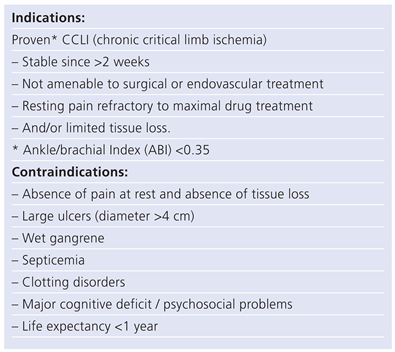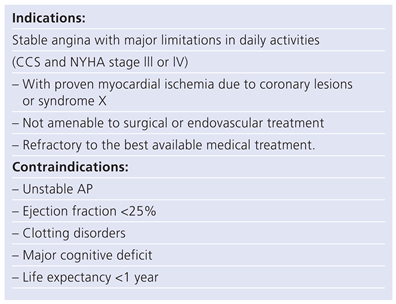Neurostimulation for Cardiovascular Diseases
Abstract
Introduction
- What have been the results in recent times?
- What are the putative treatment mechanisms involved in SCS?
- What are the best selection criteria in PAOD and AP patients?
- What are the drawbacks or complications of SCS in PAOD and AP?
- What are the future developments?
Implantation techniques



Results
Atherosclerotic chronic critical limb ischemia
Non-atherosclerotic CCLI
Refractory AP
Mechanisms of action
In PAOD
- a)
- the general pain-relieving effect of SCS leads secondarily to reversal of the sympathetic vasoconstriction, commonly elicited by painful sensations. This hypothesis is no longer tenable since it has been unequivocally demonstrated that vasodilatation always precedes, most often for days, pain alleviation [9,22];
- b)
- SCS reduces the sympathetic tone by a direct effect on spinal and supraspinal autonomic controls;
- c)
- antidromic stimulation of afferent nerve fibres leads to the release of vasoactive compounds at the peripheral nerve endings.
In refractory AP
- −
- a reduction of oxygen myocardial consumption: a human study of 20 patients stressed with atrial pacing measured significantly less lactates in the coronary sinus at a comparable pacing rate under SCS [31];
- −
- a redistribution of the coronary blood flow towards the regions with impaired myocardial perfusion, as evidenced by positron emission tomography (PET) studies in 9 patients [32];
- −
- a more efficient cardiac work. This hypothesis stems from hemodynamic investigations in mini-pigs showing substantial decreases in systemic and pulmonary vascular resistances along with significant increases in cardiac output and stroke volume during low-intensity (2 volts) SCS applied at the highest possible cervical level [33].
 |
 |
Indications, contraindications and selection criteria
Selection criteria
In PAOD
In refractory AP
Drawbacks and complications of SCS treatment
Future developments
Conclusions
Conflicts of Interest
References
- Melzack, R.; Wall, P. Pain mechanisms: a new theory. Science 1965, 150, 971–979. [Google Scholar] [CrossRef] [PubMed]
- Cook, A.W.; Oygar, A.; Baggenstos, P.; et al. Vascular disease of the extremities: Electrical stimulation of spinal cord and posterior roots. NY State J Med. 1976, 76, 366–368. [Google Scholar]
- Murphy, D.; Giles, K. Dorsal column stimulation for pain relief from intractable angina pectoris. Pain 1987, 28, 365–368. [Google Scholar] [CrossRef] [PubMed]
- Holsheimer, J. Computer modeling of spinal cord stimulation and its contribution to therapeutic efficacy. Spinal Cord. 1998, 36, 531–540. [Google Scholar] [CrossRef]
- Holsheimer, J.; Struijk, J.J. How do geometric factors influence epidural spinal cord stimulation?Aquantitative analysis by computer modeling. Stereotact Funct Neurosurg. 1991, 56, 234–249. [Google Scholar] [CrossRef]
- Ubbink, D.T.; Vermeulen, H. Spinal cord stimulation for non-reconstructable chronic critical limb ischemia (Cochrane review). In The Cochrane Library; Oxford, 2003; Issue 3; Update Software. [Google Scholar]
- Amann, W.; Berg, P.; Gersbach, P.; et al. for the SCS-EPOS Study Group. Spinal cord stimulation in the treatment of non-reconstructable stable critical leg ischemia: Results of the European peripheral vascular disease outcome study (SCS-EPOS). Eur J Vasc Endovasc Surg. 2003, 26, 280–286. [Google Scholar] [CrossRef]
- Gersbach, P.A.; Argitis, V.; Gardaz, J.-P.; von Segesser, L.K.; Haesler, E. Late outcome of spinal cord stimulation for unreconstructable and limbthreatening lower limb ischemia. Eur J Vasc Endovasc Surg. 2007, 33, 717–24. [Google Scholar] [CrossRef][Green Version]
- Spincemaille, G.H. Spinal cord stimulation in peripheral vascular disease. In Pain Research and Clinical Management; Electrical stimulation and the relief of pain; Simpson, B.A., Ed.; Elsevier, 2003; Volume 15, pp. 131–142, chap 9. [Google Scholar][Green Version]
- Bennett, D.S.; Cameron, T.L. Spinal cord stimulation for complex regional pain syndromes. In Pain Research and Clinical Management; Electrical stimulation and the relief of pain; Simpson, B.A., Ed.; Elsevier, 2003; Volume 15, pp. 110–129, chap 8. [Google Scholar][Green Version]
- Andréll, P.; Yu, W.; Gillberg, L.; et al. Long-term effects of spinal cord stimulation in refractory angina pectoris—3 year results from the EuropeanAngina Registry Link (EARL). Abstract book ESC Congress: Barcelona, 2008. [Google Scholar][Green Version]
- Mannheimer, C.; Camici, P.; Chester, M.R.; et al. The problem of chronic refractory angina pectoris; report from the ESC Joint Study Group on the treatment of refractory angina. Eur Heart J. 2002, 23, 355–370. [Google Scholar] [CrossRef]
- Mannheimer, C.; Eliasson, T.; Augustinsson, L.E.; et al. Electrical stimulation versus coronary artery bypass surgery in severe angina pectoris. The ESBY study. Circulation. 1998, 97, 1157–1163. [Google Scholar] [CrossRef]
- Ekre, O.; Eliasson, T.; Norsell, H.; et al. Long-term effects of spinal cord stimulation and coronary artery bypass grafting on quality of life and survival in the ESBY study. Eur Heart J. 2002, 23, 1938–1945. [Google Scholar] [CrossRef][Green Version]
- Hautvast, R.W.; Szabo, B.M.; DeJongste, M.J.L.; et al. Influence of spinal cord stimulation on left ventricular function in patients with refractory angina pectoris. In Proceedings of the 2nd International Symposium on Heart Failure-mechanisms and management; 1993. [Google Scholar][Green Version]
- Eliasson, T.; Augustinsson, L.E.; Mannheimer, C. Spinal cord stimulation in severe angina pectoris – presentation of current studies, indications, and clinical experience. Pain 1996, 65, 169–179. [Google Scholar] [CrossRef]
- Greco, S.; Auriti, A.; Fiume, D; et al. Spinal cord stimulation for the treatment of refractory angina pectoris: a two-year follow-up. PACE 1999, 22, 26–32. [Google Scholar] [CrossRef]
- Ten Vaarwerk, I.; Jessurun, G.; de Jongste, M.; et al. Clinical outcome of patients treated with spinal cord stimulation for therapeutically refractory angina pectoris. Heart 1999, 82, 82–88. [Google Scholar] [CrossRef] [PubMed]
- Jacobs, M.J.H.M.; Jörning, P.J.G.; Beckers, R.C.Y.; et al. Foot salvage and improvement of microvascular blood flow as a result of epidural spinal cord electrical stimulation. J Vasc Surg. 1990, 12, 354–360. [Google Scholar] [CrossRef] [PubMed]
- Gersbach, P. Microcirculatory screening for spinal cord stimulation. Crit Ischemia 1999, 9, 39–45. [Google Scholar]
- Gallay, D. Spinal cord stimulation for the treatment of peripheral vascular disease: patients selection: clinical and haemodynamic criteria. In Spinal Cord Stimulation for Peripheral Vascular Diseases; Herreros, J, Lazorthes, Y., Galley, D., Broggi, G., Eds.; ELA Madrid, 1994; Advances and controversies. [Google Scholar]
- Meyerson, B.A.; Linderoth, B. Spinal cord stimulation: mechanisms of action in neuropathic and ischaemic pain. In: Pain Research and Clinical Management, vol 15, BA Simpson ed. Electrical stimulation and the relief of pain, Elsevier 2003, chap 11, pp. 161–182.
- Tallis, R.; Jacobs, M.; Miles, J. Spinal cord stimulation in peripheral vascular disease (Editorial). Br J Neurosurg. 1992, 6, 101–105. [Google Scholar] [CrossRef]
- Linderoth, B.; Gunasekera, L.; Meyerson, B.A. Effects of sympathectomy on skin and muscle microcirculation during dorsal column stimulation: animal studies. Neurosurgery 1991, 29, 874–879. [Google Scholar] [CrossRef]
- Linderoth, B.; Herregodts, P. Meyerson BA. Sympathetic mediation of peripheral vasodilation induced by spinal cord stimulation:Animal studies of the role of cholinergic and adrenergic receptor subtypes. Neurosurgery 1994, 15, 711–719. [Google Scholar] [CrossRef]
- Croom, J.E.; Barron, K.W.; Chandler, M.J.; Foreman, R.D. Cutaneous blood flow increases in the rat hindpaw during dorsal column stimulation. Brain Res. 1996, 728, 281–286. [Google Scholar] [CrossRef]
- Croom, J.E.; Foreman, R.D.; Chandler, M.J.; Barron, K.W. utaneous vasodilatation during dorsal column stimulation is mediated by dorsal roots and CGRP. Am J Physiol. 1997, 272, H950–H957. [Google Scholar]
- Tanaka, S.; Barron, K.W.; Chandler, M.J.; et al. Low intensity spinal cord stimulation may induce cutaneous vasodilation via CGRP release. Brain Res. 2001, 896, 183–187. [Google Scholar] [CrossRef]
- Croom, J.E.; Foreman, R.D.; Chandler, M.J.; et al. Role of nitric oxide in cutaneous blood flow increases in the rat hindpaw during dorsal column stimulation. Neurosurgery 1997, 40, 565–571. [Google Scholar] [PubMed]
- Linderoth, B. Dorsal column stimulation and pain. Experimental studies of putative neurochemical and neurophysiological mechanisms. Thesis Stockholm 1992. [Google Scholar]
- Mannheimer, C.; Eliasson, T.; Anderson, B.; et al. ffects of spinal cord stimulation in angina pectoris induced by pacing and possible mechanisms of action. Br Med J. 1993, 307, 477–480. [Google Scholar] [CrossRef]
- Hautvast, R.W.; Blanksma, P.K.; DeJongste, M.J.; et al. Effect of spinal cord stimulation on myocardial blood flow assessed by positron emission tomography in patients with refractory angina pectoris. Am J Cardiol. 1996, 77, 462–477. [Google Scholar] [CrossRef]
- Gersbach, P.A.; Hasdemir, M.G.; Eeckhout, E.; von Segesser, L.K. Spinal cord stimulation treatment for angina pectoris: more than a placebo? Ann Thorac Surg. 2001, 72, S1–100. [Google Scholar] [CrossRef]
- Claeys, L.G.Y.; Horsch, S. Effects of spinal cord stimulation on ischemia inflammatory pain and wound healing in patients with peripheral arterial occlusive disease Fontaine stage lV. Pain Digest. 1997, 7, 200–203. [Google Scholar]
- Gersbach Ph Hasdemir, M.G.; Stevens, R.D.; Nachbur, B.; Mahler, F. Discriminative microcirculatory screening of patients with refractory limb ischemia for dorsal column stimulation. Eur J Vasc Endovasc Surg. 1997, 13, 464–471. [Google Scholar] [CrossRef]
- Ubbink, D.T.; Tulveski, I.I.; de Graaff, J.C.; Legemate, D.A.; Jacobs, M.J.H.M. Optimisation of the non-invasive assessment of critical limb ischemia requiring invasive treatment. Eur J Vasc Endovasc Surg. 2000, 19, 131–7. [Google Scholar] [CrossRef]
- Mannheimer, C.; Carlsson, C.A.; Emanuelsson, H.; et al. The effects of transcutaneous electrical nerve stimulation in patients with severe angina pectoris. Circulation. 1985, 71, 308–316. [Google Scholar] [CrossRef]
- Spincemaille, G.H.; Klomp, H.L.; Steyerberg, E.W.; et al. Technical data and complications of of spinal cord stimulation: data from a randomized trial on critical limb ischemia. Stereotact Funct Neurosurgery. 2000, 74, 63–72. [Google Scholar] [CrossRef]
- Gersbach, P.; Gardaz, J.P.; Ferrari, E.; et al. La stimulation électrique épidurale pour maladie vasculaire périphérique et coronarienne. Résultas et perspectives. Rev Med Suisse. 2008, 150, 797–804. [Google Scholar]
© 2010 by the authors. Attribution - Non-Commercial - NoDerivatives 4.0.
Share and Cite
Gersbach, P. Neurostimulation for Cardiovascular Diseases. Cardiovasc. Med. 2010, 13, 97. https://doi.org/10.4414/cvm.2010.01484
Gersbach P. Neurostimulation for Cardiovascular Diseases. Cardiovascular Medicine. 2010; 13(3):97. https://doi.org/10.4414/cvm.2010.01484
Chicago/Turabian StyleGersbach, Philippe. 2010. "Neurostimulation for Cardiovascular Diseases" Cardiovascular Medicine 13, no. 3: 97. https://doi.org/10.4414/cvm.2010.01484
APA StyleGersbach, P. (2010). Neurostimulation for Cardiovascular Diseases. Cardiovascular Medicine, 13(3), 97. https://doi.org/10.4414/cvm.2010.01484




